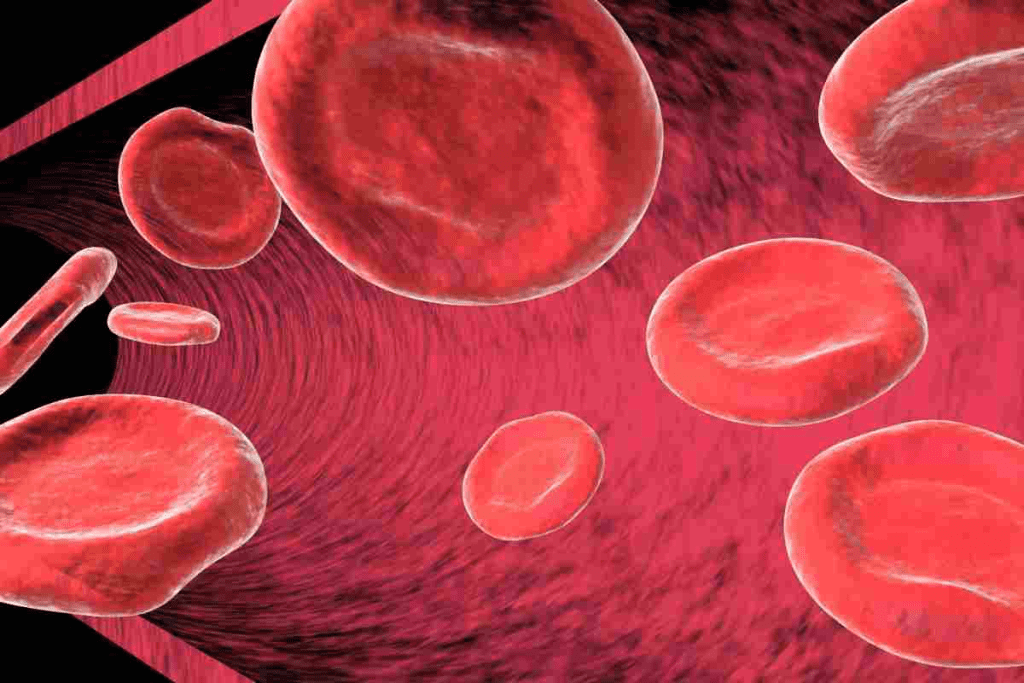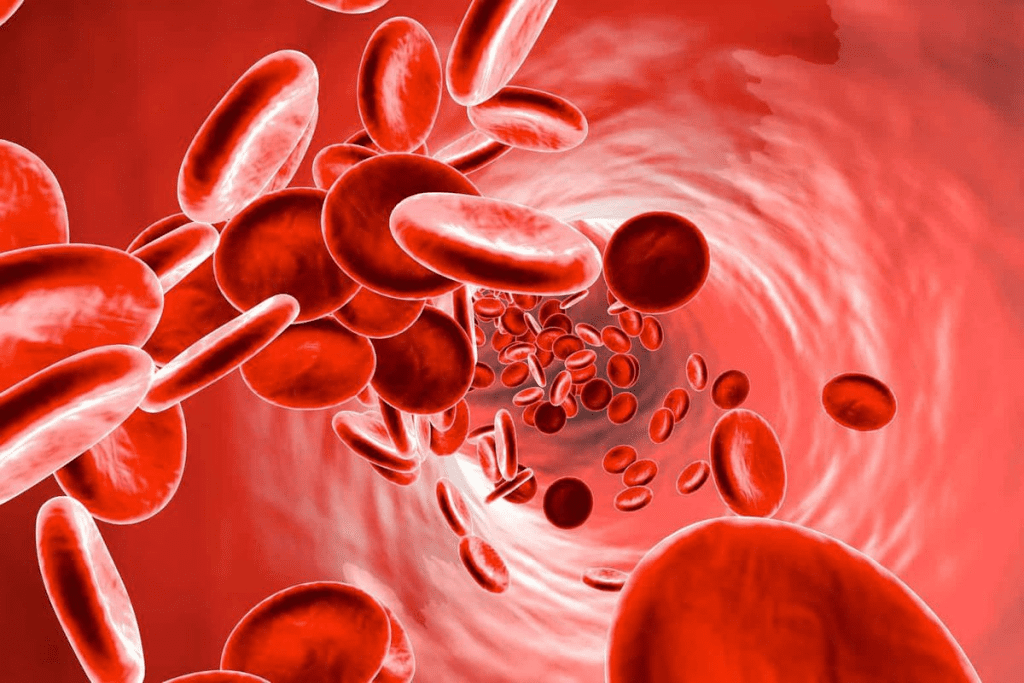Last Updated on October 21, 2025 by mcelik

Megaloblastic Anemia Symptoms: How Vitamin Deficiency Can Affect Hair Health
Vitamin deficiencies can really affect our health, and hair loss is often a surprise. Many people have hidden vitamin deficiencies, like Vitamin B12 deficiency, which is a known cause of megaloblastic anemia.
Hair loss can be distressing, and understanding its connection to megaloblastic anemia symptoms is important. Studies show that anemia megaloblastica, where red blood cells are too big, can cause hair loss. This happens because the body can’t move enough oxygen to the scalp, affecting hair growth and overall health.

Anemia, often caused by iron deficiency, is a common reason for hair loss in women. It happens when the body lacks enough red blood cells or hemoglobin. This makes it hard for tissues, like hair follicles, to get the oxygen they need.
Anemia is when you don’t have enough red blood cells or they’re not good enough. Red blood cells carry oxygen to all parts of your body. It can be caused by not eating enough nutrients, chronic diseases, or genetic problems.
Hair grows in cycles, and anemia can mess with these cycles. It doesn’t give hair follicles enough oxygen and nutrients. This can stop hair from growing normally, leading to hair loss.
There are a few types of anemia that can cause hair loss:
Knowing what kind of anemia you have is key to fixing the hair loss problem.

Megaloblastic anemia is known for its large red blood cells. This is often due to problems with DNA synthesis.
Megaloblastic anemia makes red blood cells too big and not work right. It happens when DNA synthesis goes wrong. This is usually because of a lack of vitamin B12 or folate.
These vitamins are key for making red blood cells. Without them, the body can’t make enough healthy red blood cells. This leads to a lack of healthy cells in the blood.
Megaloblastic anemia is often mixed up with macrocytic anemia. Both have large red blood cells. But, macrocytic anemia can have many causes. Megaloblastic anemia is specific to vitamin B12 or folate deficiency.
Knowing the difference is important for treatment. Not all macrocytic anemia is megaloblastic.
Megaloblastic anemia’s frequency changes based on the population and cause. It’s more common in those lacking vitamin B12 or folate. This includes vegetarians and people with nutrient absorption issues.
At risk are those with poor diets, certain gut problems, and some medications. Spotting these risks helps prevent megaloblastic anemia.
Knowing the symptoms of megaloblastic anemia is key for early treatment. It’s a condition where red blood cells are too big and don’t work right. This can cause serious health problems if not treated.
The symptoms of megaloblastic anemia can really affect your life. Some common ones are:
Neurological symptoms can also happen because of a lack of vitamin B12. This vitamin is important for your nervous system. Some symptoms include:
Megaloblastic anemia can also affect your hair and skin. Some signs are:
Spotting these symptoms early is important for treating megaloblastic anemia. Early treatment can help manage symptoms, avoid serious problems, and improve your life quality.
To understand megaloblastic anemia, we must look at nutritional and genetic factors. This condition mainly happens when there’s not enough vitamin B12 or folate. These nutrients are key for DNA and red blood cell growth.
Vitamin B12 deficiency is a big reason for megaloblastic anemia. People who don’t eat animal products, like vegans, might not get enough. Malabsorption also plays a part, like in pernicious anemia where the body can’t absorb B12 well.
“Vitamin B12 is vital for DNA making, and without it, red blood cells don’t mature right.”
| Cause | Description | Impact |
| Dietary Deficiency | Lack of vitamin B12 in diet, common in vegans | Megaloblastic anemia |
| Malabsorption | Impaired absorption, often due to pernicious anemia | Megaloblastic anemia |
Folate deficiency is another main cause of megaloblastic anemia. Folate helps with DNA making and fixing. Not enough folate in the diet or needing more, like during pregnancy, can cause this. Increased demand during pregnancy makes folate supplements important to avoid anemia.
Genetics also affect megaloblastic anemia. Some inherited conditions make it hard for the body to use B12 and folate. For example, inherited disorders can mess with vitamin metabolism, leading to anemia.
In summary, megaloblastic anemia comes from a mix of nutritional and genetic issues. Knowing these causes helps doctors diagnose and treat it better.
The link between megaloblastic anemia and hair loss is complex. It involves the way cells in hair follicles divide. Hair loss is a sign of the biochemical problems caused by the condition.
Hair follicle cells divide quickly. Hair growth depends on DNA synthesis. In megaloblastic anemia, vitamin B12 or folate deficiency hampers DNA synthesis.
This leads to large, dysfunctional cells. These cells can’t divide right, stopping hair growth and causing loss.
B vitamins, like vitamin B12 and folate, are key for hair health. They help make nucleic acids and keep the hair growth cycle going. Without enough, hair texture changes and loss can happen.
Hair loss in megaloblastic anemia comes from vitamin deficiencies and DNA issues. The table below shows the main factors:
| Factor | Role in Hair Health | Effect of Deficiency |
| Vitamin B12 | Essential for DNA synthesis and cell division | Impaired DNA synthesis, leading to hair loss |
| Folate | Critical for nucleic acid synthesis and repair | Disruption of hair growth cycle, potentially causing hair loss |
| DNA Synthesis | Necessary for cell division and hair growth | Impaired cell division, leading to halted hair growth |
Knowing these mechanisms helps in finding treatments. Treatments should fix the anemia and help hair health.
Understanding pernicious anemia is key because it often causes megaloblastic anemia. This affects hair growth and more. It’s an autoimmune disease that leads to a lack of vitamin B12. This vitamin is vital for making red blood cells and keeping the nervous system healthy.
Pernicious anemia happens when the immune system attacks the stomach lining. This lining makes intrinsic factor, a protein needed for vitamin B12 absorption. Without enough intrinsic factor, the body can’t get enough vitamin B12 from food.
At first, symptoms may be mild, like feeling tired or weak. But if not treated, it can cause serious problems. One issue is megaloblastic anemia, where red blood cells are too big and don’t work right.
Pernicious anemia is an autoimmune disease. This means the immune system attacks itself. It targets the intrinsic factor and the cells that make it. This attack reduces vitamin B12 absorption.
Studies show genetics play a role in getting pernicious anemia. Knowing this can help find who’s at risk. It might also lead to new treatments that fight the autoimmune part of the disease.
Hair loss from pernicious anemia can look different for everyone. Some people might see thinning all over, while others lose hair in certain spots.
This hair loss comes from a lack of vitamin B12. Without enough, hair follicles don’t work well. This can weaken hair growth and lead to hair loss.
| Condition | Primary Cause | Effect on Hair |
| Pernicious Anemia | Autoimmune destruction of parietal cells | Hair loss due to vitamin B12 deficiency |
| Megaloblastic Anemia | Vitamin B12 or folate deficiency | Impaired hair growth, possible hair loss |
It’s important to know the difference between macrocytic and megaloblastic anemia. Both affect red blood cell production but in different ways. This knowledge helps doctors give the right treatment.
Macrocytic anemia is when your red blood cells are bigger than usual. It can happen for many reasons, like not enough vitamin B12 or folate, drinking too much alcohol, or taking certain medicines. The main sign is that your red blood cells are larger than they should be.
Key Features of Macrocytic Anemia:
Megaloblastic anemia is a type of macrocytic anemia. It’s when your red blood cells are too big and don’t work right. It often happens because you don’t have enough vitamin B12 or folate. These are important for making DNA.
“Megaloblastic anemia is a condition where the bone marrow produces large, abnormal red blood cells that are unable to function properly, often due to a deficiency in vitamin B12 or folate.”
Macrocytic and megaloblastic anemia both have big red blood cells. But megaloblastic anemia has a special feature: megaloblasts in the bone marrow. These conditions can make your hair fall out because of vitamin B12 or folate shortages.
| Characteristics | Macrocytic Anemia | Megaloblastic Anemia |
| Red Blood Cell Size | Large | Large, abnormal |
| Underlying Causes | Various, including vitamin deficiencies | Primarily vitamin B12 or folate deficiency |
| Impact on Hair Health | Potential hair loss due to underlying causes | Hair loss, among other symptoms, due to deficiency |
Knowing the difference between macrocytic and megaloblastic anemia is key. It helps doctors give the right treatment. This knowledge is important for good care.
To diagnose megaloblastic anemia, doctors use blood tests and sometimes bone marrow exams. Getting the diagnosis right is key to treating it well.
The first step is usually a complete blood count (CBC). It checks the levels of red, white blood cells, and platelets. A CBC can spot macrocytic anemia, where red blood cells are bigger than usual.
A peripheral smear is also done. It looks for changes in red blood cells, like hypersegmented neutrophils. These changes point to megaloblastic anemia.
| Test | Normal Findings | Findings in Megaloblastic Anemia |
| Mean Corpuscular Volume (MCV) | 80-100 fL | Often >100 fL |
| Red Blood Cell Count | Varies by age and sex | Decreased |
| Neutrophil Segmentation | 3-5 lobes | Hypersegmented (more than 5 lobes) |
Testing for vitamin B12 and folate levels is key. Low levels of either can cause megaloblastic anemia.
These tests help figure out why you have it. They guide how to treat it.
Sometimes, a bone marrow exam is needed. It looks at bone marrow cells to check for abnormalities.
This test can show if there are megaloblastic changes in the marrow. It helps confirm the diagnosis.
Megaloblastic anemia is treated by adding the missing vitamins and changing what we eat. The main goal is to fix the vitamin B12 or folate problem. This helps make red blood cells the right way again.
People with a vitamin B12 shortage need replacement therapy. This is given through shots, starting with many doses and then fewer as needed. Some people might also take oral supplements, but shots work better for some.
Those with folate deficiency need folate supplements. Oral supplements usually work well. The amount needed depends on how bad the shortage is and how well the patient responds to treatment.
Eating the right foods is key in managing megaloblastic anemia. Foods high in vitamin B12 and folate, like leafy greens and animal products, are recommended. Getting help from a nutritionist can make sure the diet is balanced and supports healing.
In summary, treating megaloblastic anemia well needs a mix of vitamin supplements and diet changes. Fixing the vitamin problems and improving nutrition helps patients get better and stay healthy.
Hair loss is a common symptom of megaloblastic anemia. But, with the right treatment, hair can grow back and health can improve. This condition, marked by large red blood cells, can cause hair loss if not treated. Fixing nutritional deficiencies can help reverse this issue.
The time it takes for hair to grow back after treating megaloblastic anemia varies. It depends on how severe the condition is and how well the treatment works. Generally, hair starts growing back a few months after fixing the deficiency.
Here’s what you can expect:
| Timeframe | Expected Outcome |
| 0-3 months | Initial signs of hair regrowth may start to appear as the body responds to treatment. |
| 3-6 months | Noticeable hair regrowth becomes more apparent as the hair follicles recover. |
| 6-12 months | Significant hair regrowth can be observed, with continued improvement in overall hair health. |
During recovery, it’s key to use supportive hair care strategies. This helps promote healthy hair growth. Here are some tips:
In some cases, hair loss may not stop even after treating megaloblastic anemia. If this happens, you might need extra hair loss treatments. These can include:
It’s important to talk to a healthcare professional or dermatologist. They can help decide the best treatment for your hair loss.
Preventing megaloblastic anemia is possible by focusing on diet and lifestyle. A balanced diet is key, say health experts.
Eating foods rich in vitamin B12 and folate is vital. Vitamin B12 is in animal products like meat, fish, and dairy. Folate is in leafy greens, legumes, and fortified cereals.
A study in a medical journal shows that eating these nutrients lowers megaloblastic anemia risk.
Screening high-risk groups is a key prevention step. This includes pregnant women, vegetarians, and those with gut issues.
Some lifestyle choices can help prevent megaloblastic anemia. Drinking less alcohol and not smoking helps your health and reduces deficiency risk.
Regular health check-ups and knowing your risk factors help catch and prevent megaloblastic anemia early.
Untreated megaloblastic anemia can lead to serious complications. It affects the quality of life greatly. This condition causes the body to make large red blood cells.
Neurological damage is a severe issue from untreated megaloblastic anemia. Lack of vitamin B12 or folate can harm the nervous system. This can cause numbness, trouble walking, and mood changes.
Early diagnosis and treatment are key to avoid lasting nerve damage.
Megaloblastic anemia also raises the risk of heart disease. It can cause high levels of homocysteine in the blood. This increases the chance of heart attacks and strokes.
| Cardiovascular Risk Factors | Description |
| Increased Homocysteine Levels | Associated with higher risk of heart attacks and strokes |
| Anemia-Related Fatigue | Can lead to reduced physical activity, further increasing cardiovascular risk |
Untreated megaloblastic anemia can also cause permanent hair and skin changes. Hair loss can be severe and sometimes permanent if treatment is delayed.
Hair loss can have a big psychological impact. It can lower self-esteem, cause anxiety, and depression. It’s important to offer support and counseling.
Dealing with the emotional side of hair loss is a big part of managing megaloblastic anemia.
It’s important to know about megaloblastic anemia to tackle its symptoms, like hair loss. This condition makes red blood cells too big. It’s usually due to a lack of vitamin B12 or folate.
To manage megaloblastic anemia, find out what’s causing it. This might be pernicious anemia, where the body can’t absorb vitamin B12. Treatment includes vitamin B12 shots and folate pills. Also, eating right is key.
With the right treatment, hair loss from megaloblastic anemia can be reversed. Good hair care helps too. To avoid this condition, eat well and get checked if you’re at risk. This can prevent serious problems like nerve and heart issues, and permanent hair and skin damage.
In short, megaloblastic anemia needs careful handling to avoid serious problems. Knowing its causes, symptoms, and treatments helps. This way, people can recover and stay healthy.
Megaloblastic anemia is when your body makes big red blood cells that don’t work right. It’s often caused by not having enough vitamin B12 or folate.
Hair loss happens because the hair follicles can’t divide cells properly. This is due to a lack of B vitamins, like vitamin B12.
Symptoms include feeling very tired, weak, and pale. You might also have shortness of breath and hair loss. Skin changes can also occur.
Yes, it can be treated. You might need vitamin B12 shots or pills, and folate supplements. Changing your diet can also help.
Hair regrowth time varies. But, it usually takes a few months after starting treatment. Some people see hair growth in 3-6 months.
Macrocytic anemia means your red blood cells are too big. Megaloblastic anemia is a type of macrocytic anemia. It’s named after the megaloblasts in your bone marrow.
Yes, pernicious anemia can cause hair loss. It’s an autoimmune condition that leads to vitamin B12 deficiency. Hair loss is one of its symptoms.
Doctors use a few tests to diagnose it. They check your blood, bone marrow, and vitamin levels. This helps confirm the diagnosis.
If left untreated, it can cause serious problems. These include neurological issues, heart risks, and permanent hair and skin damage.
To prevent it, eat foods rich in vitamin B12 and folate. Screen for deficiencies if you’re at risk. Also, avoid lifestyle habits that lead to deficiencies.
Subscribe to our e-newsletter to stay informed about the latest innovations in the world of health and exclusive offers!